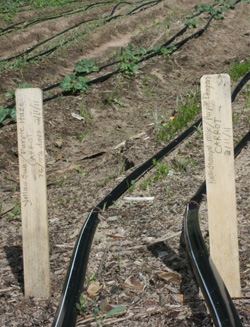
But what do we mean by "field-testing"?
In agricultural science, there are actually several different methods to test how well crops grow in the field. For this project, farm advisors are planting varieties of vegetables, monitoring the plants' growth and recording information about the plants.
For each row of crops, the advisors will record the days when:
- the seeds are planted
- the plants' leaves first emerge from the ground (aka “emergence”)
- the plants begin to bloom (for plants with edible flowers or fruit)
- the plants are harvested
Farm advisors will also judge the plant's appearance, whether its health looks very good, good, fair or poor.

"What I'm looking for there is vigor, color, leaf size, stalk size and other characteristics. Do the plants look healthy and vigorous?" explained Aziz Baameur, farm advisor in Santa Clara, Santa Cruz and San Benito counties. "This is very subjective, but gives us a general judgment of plant health and allows for comparison between different varieties of the same vegetable."
To help judge how many of the seeds grew into plants, the farm advisors will estimate the "stand" in the field. To do that, they will count or estimate the number of plants per a given area, for example, per square foot.
When it comes time to harvest the crop, the farm advisors will also record how many vegetables they harvested and the total weight of the vegetables. Knowing this information can help estimate the size of the vegetables. For example:
- Harvest from Variety A plants: 200 carrots, weighing 30 pounds total
- Harvest from Variety B plants: 300 carrots, weighing 20 pounds total
- Harvest from Variety C plants: 100 carrots, weighing 18 pounds total
From this example, which variety of plants grows the biggest individual carrots?
Some vegetables are harvested all at once, while others are harvested repeatedly every few days or every week. So the farm advisors will also record when, how many and total weight for each time they harvest vegetables.
How can this information help a farmer? When farmers are deciding which crops to plant, it is important they know what to expect so they can make plans to sell their vegetables. How many days does it take for a particular variety of Romanesco to grow from seed to harvest? Does this other variety of plant grow smaller or larger radishes? If I plant 100 seeds, how many plants can I expect to grow?
The answers to these questions will vary based on the vegetable variety, where it is planted and when it is planted — which is one more reason why UC farm advisors are planting the same varieties throughout the state at numerous times.